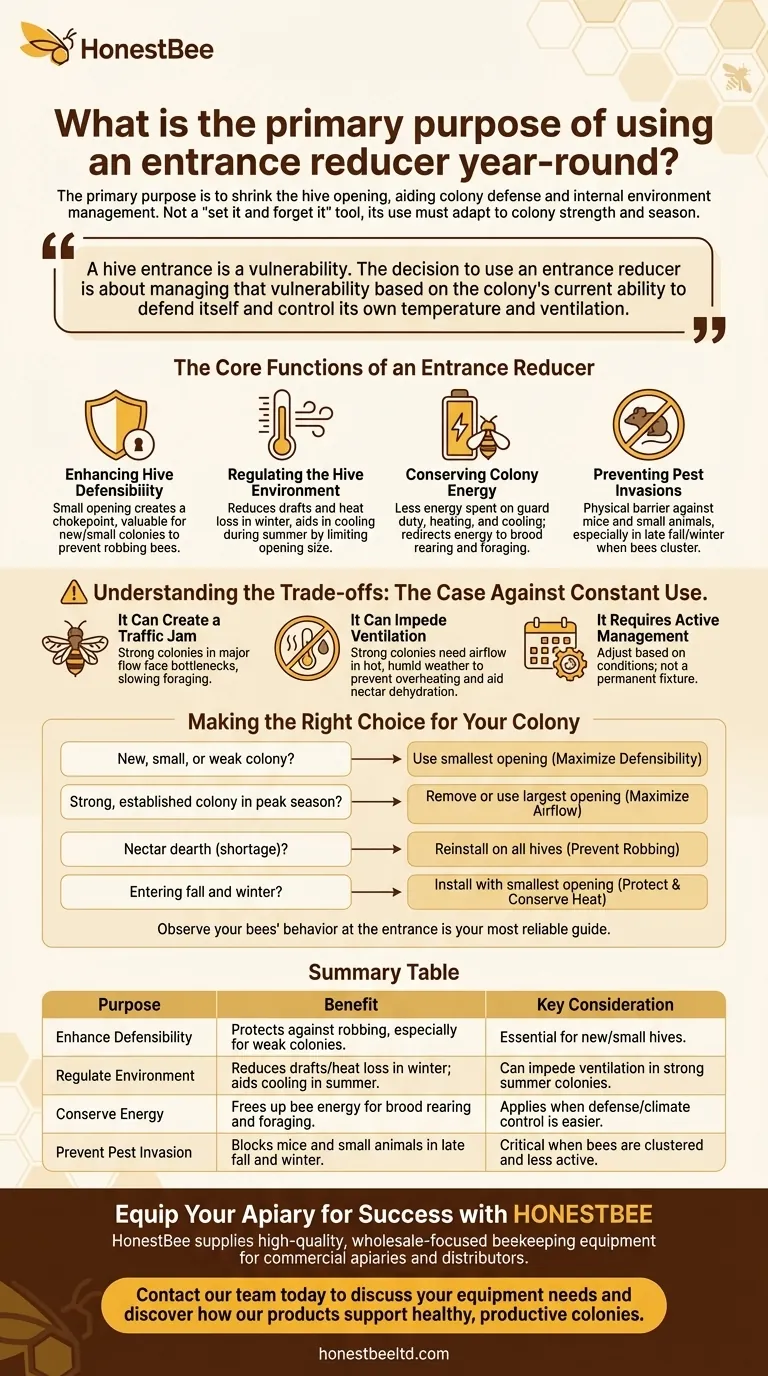The primary purpose of using an entrance reducer is to shrink the hive opening, making it easier for the colony to defend against intruders and manage its internal environment. While it offers benefits throughout the year, its use must be adapted to the colony's strength and the current season, as a year-round "set it and forget it" approach can be detrimental.
A hive entrance is a vulnerability. The decision to use an entrance reducer is about managing that vulnerability based on the colony's current ability to defend itself and control its own temperature and ventilation.

The Core Functions of an Entrance Reducer
An entrance reducer is a simple wooden block, but it serves several critical purposes that directly impact a colony's health and stability.
Enhancing Hive Defensibility
A smaller entrance is a chokepoint that guard bees can more effectively protect. This is the most important function of a reducer.
It is particularly valuable for new or small colonies, which have fewer guards to defend against robbing bees from stronger nearby hives. Using a reducer helps prevent robbing before it can start.
Regulating the Hive Environment
The reducer helps the bees manage their internal climate. By limiting the size of the opening, it reduces drafts and heat loss.
This helps the colony stay warm in the winter and can reduce the energy bees must expend fanning to circulate air and cool the hive in the summer.
Conserving Colony Energy
By assisting with defense and climate control, the reducer allows the bees to allocate their energy elsewhere.
Fewer bees are needed for guard duty, and less energy is spent on heating or cooling. This conserved energy can be redirected to brood rearing and foraging.
Preventing Pest Invasions
During late fall and winter, the reducer is a physical barrier against pests.
When bees form their winter cluster, they are less able to patrol the hive. A reducer with a small opening effectively blocks mice and other small animals from entering and nesting inside the warm, food-rich hive.
Understanding the Trade-offs: The Case Against Constant Use
Using an entrance reducer year-round on a strong colony is often counterproductive. The key is to adapt its use to the colony's needs.
It Can Create a Traffic Jam
A strong, populous colony during a major nectar flow has thousands of foragers coming and going.
A small entrance creates a bottleneck, slowing down foraging operations and potentially reducing the amount of honey your hive can produce.
It Can Impede Ventilation
In hot, humid weather, a large, healthy colony needs maximum airflow to prevent the hive from overheating and to effectively dehydrate nectar into honey.
A reducer can trap heat and moisture, increasing stress on the colony. Some hives will "beard" on the front of the hive in an attempt to cool down, a sign of insufficient ventilation.
It Requires Active Management
The most common mistake is failing to adjust the reducer as conditions change. A setting that is perfect for a small new package in April is dangerous for that same booming colony in July.
Beekeeping is not a passive hobby; it requires observation and intervention. The reducer is a tool, not a permanent fixture.
Making the Right Choice for Your Colony
Your decision should be based on a combination of colony strength, time of year, and local pest pressure.
- If you have a new, small, or weak colony: Use the reducer with its smallest opening to maximize defensibility while the colony builds its population.
- If you have a strong, established colony in peak season: Remove the reducer entirely or use its largest opening to maximize airflow and prevent traffic jams during the nectar flow.
- If your area is experiencing a nectar dearth (shortage): Reinstall the reducer on all hives, regardless of strength, to proactively prevent robbing behavior.
- As you enter fall and winter: Install the reducer with its smallest opening to protect against robbing, block mice, and help the colony conserve heat.
Ultimately, observing your bees' behavior at the entrance is your most reliable guide.
Summary Table:
| Purpose | Benefit | Key Consideration |
|---|---|---|
| Enhance Defensibility | Protects against robbing bees, especially for weak colonies. | Essential for new/small hives. |
| Regulate Environment | Reduces drafts/heat loss in winter; aids cooling in summer. | Can impede ventilation in strong summer colonies. |
| Conserve Energy | Frees up bee energy for brood rearing and foraging. | Applies when defense/climate control is easier. |
| Prevent Pest Invasion | Blocks mice and small animals in late fall and winter. | Critical when bees are clustered and less active. |
Equip Your Apiary for Success with HONESTBEE
Managing your hives effectively requires the right tools, like durable entrance reducers. At HONESTBEE, we supply commercial apiaries and beekeeping equipment distributors with high-quality, wholesale-focused beekeeping supplies designed for professional use.
Let us help you strengthen your hive management strategy. Contact our team today to discuss your equipment needs and discover how our products support healthy, productive colonies.
Visual Guide

Related Products
- Multi-Functional Rotary Hive Entrance Disc for Beekeeping
- Multi-Functional Sliding Hive Entrance for Beekeeping
- HONESTBEE Advanced Ergonomic Stainless Steel Hive Tool for Beekeeping
- Beehive Entrance Discs Plastic Bee Entrance Disc for Bee Hives
- Boardman Entrance Bee Feeder Durable Galvanized Steel and Wood Construction for Beekeeping
People Also Ask
- What does a fully open setting on a round beehive entrance disc allow? Maximize Foraging & Ventilation
- What are the adjustable functions of the circular metal beehive entrance disc? Master Hive Access Control
- How does entrance configuration vary seasonally for beekeepers? A Guide to Year-Round Hive Health
- What are the four entrance options provided by the steel entrance disc? Master Hive Traffic & Protection
- What does a fully closed setting on a round beehive entrance disc indicate? A Guide to Hive Security



















